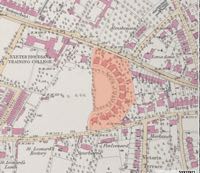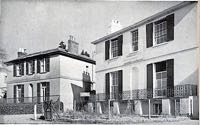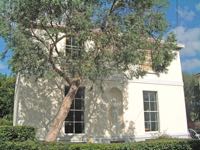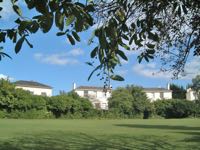
Baring Crescent
Page updated 21st June 2019
Work started to build Baring Crescent on 3rd September 1818 with twelve houses completed by 1828. The development was by a Mr John Brown 'the projector of this extensive improvement to the city of Exeter'. They were described at the time as 'superior cottages' and have simple, if striking façades. The houses are built in a semi-circle with gardens, an access road and a communal pleasure garden in the front.
Vandals strike
In November 1852 the residents were disturbed by an act of vandalism in the crescent - "Disgraceful Conduct - On Monday evening some scoundrels broke the windows of several houses in Baring Crescent, by throwing stones from the Heavitree road. A reward of £10 was offered on Tuesday for such information as will lead to their conviction, and on the evening of that day the offence was repeated."
The residents of Baring Crescent were the well educated and cultured in the 19th-Century. Mr J W L Ashe was a professor of the pianoforte and musical entrepreneur. His daughter Miss Florence Ashe gave several recitals of the pianoforte at their house at no 11. Schubert appears to have been particularly popular, but she also offered Beethoven, Bach and Chopin to an appreciative audience in October 1868. No 12 Baring Crescent was home to Mrs Ellen Julia Hand who ran a ladies school from the house, while in 1890, Admiral and Mrs White entertained to raise funds for the seamen's' mission. In 1894, Lady Bowring widow of Sir John, lived at no 7, probably the last of the family to remain in the city.
In 1896, Exeter Fire Brigade ran their annual competition at Baring Crescent Field, Magdalen Road, which was designed to "encourage the firemen in their efforts in saving life and the speedy extinction of fire in the city." Races including sack races were part of the afternoon. Baring Crescent Fields had been the venue for an ice-skating rink during the 1870's, but twenty years later the land had been given over to housing. Gradually Heavitree was being joined with Exeter and in September 1898, the process was hastened when Miss Holmes in Baring Crescent Villas sold the house and five or six acres to the Training College to allow it to expand.
Three of the houses were burnt out during the blitz and eight saved due to the prompt action of the fire watch. Ten houses survive, leaving a pleasant, if slightly austere semi-circle of houses with a private, semi-circular pleasure ground in front. Although described as 'cottages' they had eight bedrooms, a butlers pantry, wine and beer cellars, a housekeeper's room, a breakfast room, a dining room and two drawing rooms. Plus the usual kitchens and other workrooms.
The Barings Bank Fiasco
The crescent is named after Sir Thomas Baring; his grandfather, John Baring, a Lutheran migrated to Exeter from Bremen, Germany in 1717 and married Elizabeth Vowler, the daughter of a wealthy grocer; At his death in 1748, Baring was the wealthiest merchant in Exeter. His son expanded the Baring empire and established the world famous Baring Brothers Merchant Bank in London, which was, in 1995, the victim of the infamous Nick Leeson, who bankrupted the firm for £1.3 billion through his share dealing in Singapore - Barings were sold for £1 to the Dutch ING, after 233 years of trading.
The modern Baring Crescent has both residential and commercial occupants. Businesses include surveyors, property developers, a recycling company and private tuition. It has also housed a dance school and software developer. Some houses are divided into separate apartments which sell for a quarter of a million pounds or more, while a house and gardens are currently valued at £1.2 million.
│ Top of Page │



